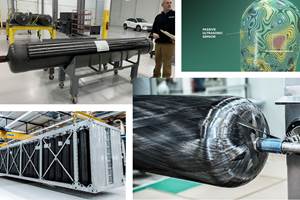Tooling considerations
The molds used for forming composites, also known as tools, can be made from virtually any material. For parts cured at ambient or low temperature, or for prototyping, where tight control of dimensional accuracy isn't required, materials such as fiberglass, high-density foams, machinable epoxy "boards"or even clay or
Share
The molds used for forming composites, also known as tools, can be made from virtually any material. For parts cured at ambient or low temperature, or for prototyping, where tight control of dimensional accuracy isn't required, materials such as fiberglass, high-density foams, machinable epoxy "boards"or even clay or wood/plaster models are often suitable. Tooling costs and complexity increase as the part performance requirements and the number of parts to be produced go up. High-rate production tools are generally made of robust metals that can stand up to repeated cycles and maintain good finish and dimensional accuracy.
The molds in which high-performance composite parts are formed can be made from carbon fiber/epoxy, monolithic graphite, castable graphite, ceramics or metals. Each material offers unique capabilities and drawbacks. Sometimes called "hard"tooling, ceramic and metal tooling is relatively heavy and able to withstand many thousands of production cycles. Composite tools, sometimes called "soft"tooling, are more vulnerable to wear and typically find service in low-volume production.
Steel and aluminum are less expensive and more readily available than high-performance metal alloys, but during autoclave cure, the CTE mismatch is often too extreme for compatibility with most advanced composite parts. Higher-priced metal alloys, such as Invar, offer closer CTE matches.
Composite tools made from traditional tooling prepregs offer several advantages, among them a CTE close to the part CTE, helping the part maintains dimensional integrity during cure. Plus, in relatively short-run applications, several suitable tools can be made with composite materials for less than the cost of a single hard tool. Like those made on hard tooling, parts made on composite tools can be cured in an autoclave or oven, or by integral heating, in which individual heating elements are placed inside the tool.
One such product in this category is HexTOOL from Hexcel (Dublin, Calif.), a machinable carbon fiber/bismaleimide (BMI) composite tooling material. It's comprised of prepreg strips randomly distributed onto a release paper to form a larger mat. After layup and cure, it can be machined like metal, has a coefficient of thermal expansion to match carbon/epoxy parts and can survive 500 autoclave cycles, all with a build and cost time comparable to existing alternatives.
Commercialized tooling design software is reducing the time it takes to model and manufacture a tool - including back-up structure - in some cases, by 80 percent. New inspection systems give tooling suppliers and fabricators a way to verify a tool's dimensional accuracy prior to and during production. In recent years, a variety of low-cost modeling materials that maintain dimensional stability at higher temperatures have made inroads into traditional toolmaking.
No matter what the tooling material, the importance of mold release agents cannot be over-emphasized. Releases create a barrier between the mold and part, preventing part/mold adhesion and facilitating part removal. For open molding, most releases today are waxes or are based on polymer chemistry. Of these, most are polymers in solvent-based carrier solutions, such as an aliphatic hydrocarbon blend. Some manufacturers prefer naptha-based releases, which have longer shelf life and faster evaporation rates and are considered to be less damaging to composite tool surfaces. Increasingly strict environmental regulations encouraged development of water-based release agents, which do not produce VOCs and clean up more easily, with less skin irritation.
Semipermanent polymer mold release systems enable multiple parts to be molded and released with a single application, in contrast to traditional paste waxes that need to be reapplied for each part. Semipermanents, which are preferred for better control over VOC emissions, have been formulated specifically to meet the needs of resin transfer molding (RTM) and other closed mold processes.
Internal release agents, added to the resin or gel coat and used instead of or in addition to external agents on the mold surface, further reduce emissions, and have negligible effects on a part's physical properties and surface finish. Internal release formulations are required for pultrusion processing, because the part is pulled continuously through the die, allowing no opportunity for intermittent application of external releases to the die surface.
Related Content
Novel composite technology replaces welded joints in tubular structures
The Tree Composites TC-joint replaces traditional welding in jacket foundations for offshore wind turbine generator applications, advancing the world’s quest for fast, sustainable energy deployment.
Read MoreHexagon Purus Westminster: Experience, growth, new developments in hydrogen storage
Hexagon Purus scales production of Type 4 composite tanks, discusses growth, recyclability, sensors and carbon fiber supply and sustainability.
Read MoreJEC World 2023 highlights: Recyclable resins, renewable energy solutions, award-winning automotive
CW technical editor Hannah Mason recaps some of the technology on display at JEC World, including natural, bio-based or recyclable materials solutions, innovative automotive and renewable energy components and more.
Read MoreCirculinQ: Glass fiber, recycled plastic turn paving into climate solutions
Durable, modular paving system from recycled composite filters, collects, infiltrates stormwater to reduce flooding and recharge local aquifers.
Read MoreRead Next
Plant tour: Daher Shap’in TechCenter and composites production plant, Saint-Aignan-de-Grandlieu, France
Co-located R&D and production advance OOA thermosets, thermoplastics, welding, recycling and digital technologies for faster processing and certification of lighter, more sustainable composites.
Read MoreAll-recycled, needle-punched nonwoven CFRP slashes carbon footprint of Formula 2 seat
Dallara and Tenowo collaborate to produce a race-ready Formula 2 seat using recycled carbon fiber, reducing CO2 emissions by 97.5% compared to virgin materials.
Read MoreVIDEO: High-volume processing for fiberglass components
Cannon Ergos, a company specializing in high-ton presses and equipment for composites fabrication and plastics processing, displayed automotive and industrial components at CAMX 2024.
Read More






















